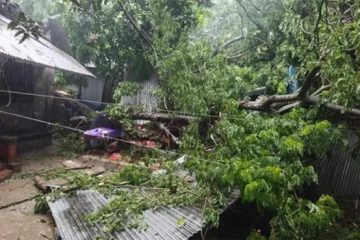 Though the government has taken various initiatives for curbing traffic congestion, no tangible sign of improvement is visible in almost all the important points in the capital Dhaka.
Though the government has taken various initiatives for curbing traffic congestion, no tangible sign of improvement is visible in almost all the important points in the capital Dhaka.
The government’s efforts to ease the nagging traffic congestion have failed due to shortage of equipment and lack of coordination among the agencies, sources said.
High officials of traffic police told The New Nation yesterday that hawkers, indiscriminate parking and illegal establishments have occupied vast areas of roads resulting in the irritating traffic jams in the city.
The traffic wing of Dhaka Metropolitans police (DMP) has not sufficient manpower to maintain traffic system in the city, police added.
The DMC traffic wing has sent several letters to the concerned authority for requisition of more forces in the wing, they said.
Traffic situation across the capital is deteriorating gradually like an epidemic form much to the plight of the city residents. The capital is again witnessing congestion from morning till late night in almost every working days in most parts of the city, causing untold sufferings to hundreds of commuters. It usually takes about one hour and a half hours to travel a distance of only six kilometres during peak times.
A resident of the city told The New Nation yesterday that the communications Minister put emphasis on curbing traffic jams in the city but his ministry has not given any directive to the traffic police and concerned persons in curbing traffic jams.
In the recent years, it has been a public demand that the government should take steps to ease Dhaka traffic congestion.
The government has a plan to introduce more commuter trains connecting Dhaka with its adjacent districts and proposed elevated expressway to free the capital from traffic congestion.
In front of the Shopping malls at New Market, Mouchak, Gulshan, Panthopath Bosundhara shopping centre, traffic situation are always worse. The worst traffic-vulnerable points also include Jatrabari, Hatkhola, Shapla Chattar, Gulistan, Paltan, New Market, Science Laboratory, Shahbagh, Bangla Motor, Sonargaon-crossing, Farmgate, Manik Mian Avenue, Asadgate, Shyamoli, Kalyanpur, Gabtoli, Mirpur-Goolchakkar, Mohakhali, Khilgaon, Banani, Mouchak, Kakrail and Malibagh.
Now-a-days residential areas are also experiencing heavy traffic-jam. The areas include Dhanmondi, Banani, Gulshan and other prime residential locations.
A large number of cars are parked illegally on both sides of the road, which is one of the main causes for traffic congestion in the city.
Police sources said parking on the roads causes serious traffic congestion in different city areas.
They jostle for space on the narrow roads with another half-million peddle-rickshaws turning the traffic system in the metropolis further in a shamble situation.
Traffic congestion in Dhaka eats up Tk 19,555 crore a year, a study said recently.
The findings were revealed at a seminar on “Traffic congestion in Dhaka and its impact on business: Some remedial measures” organised jointly by Metropolitan Chamber of Commerce and Industry (MCCI) and the Chartered Institute of Logistics and Transport at the MCCI.
It suggests that mass transit system be introduced and power be decentralised. It said the two remedial measures could save the businesses, commuters and city dwellers from financial losses and waste of their working hours.
Since nothing can be done to further widen our city streets; and given the fact that most of our motor and other vehicle drivers have no idea of traffic lanes or lane discipline; the only way out for us is to implement ‘birth control’ measures for all reconditioned vehicles.
By this, we mean that we should reduce the number of reconditioned vehicles on the city roads. Further, we should charge hefty fees for such vehicles driving in Dhaka at the points of entry to the city, said the study.
The study finds that about 3.2 million business hours are lost every day, which is about one hour per working people.
MCCI President Anis Ud Dowla said streets in Dhaka city are very inadequate against the demand. He said only 6 to 7 percent area of Dhaka is for roads against the standard of 25 to 30 percent.
Shafiqur Rahman, DMP Joint Commissioner (Traffic) said without reducing private cars, the capital cannot control the traffic jams.
Many vehicles, including auto-richshaws, have to wait for a long time for colleting CNG gas from the refuelling stations in three or four lines occuping the road, that also creates trafic jams in the city.
Besides, additional forces are also needed for curbing trafic jams, he added.




















